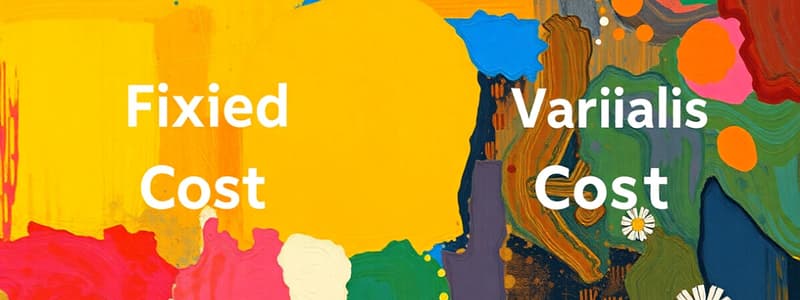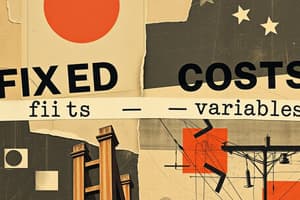Podcast
Questions and Answers
Which factor primarily distinguishes the short run from the long run in economics?
Which factor primarily distinguishes the short run from the long run in economics?
- The level of output the company is able to produce.
- The overall profitability of the business.
- The market demand for the product.
- The presence of fixed costs in the short run versus their absence in the long run. (correct)
If a firm increases its variable inputs while holding fixed inputs constant, and the resulting increase in output becomes smaller and smaller, this demonstrates:
If a firm increases its variable inputs while holding fixed inputs constant, and the resulting increase in output becomes smaller and smaller, this demonstrates:
- Economies of scale.
- The law of diminishing returns. (correct)
- Increasing returns to scale.
- Constant returns to scale.
Which of the following costs is most likely to be a fixed cost for a manufacturing company?
Which of the following costs is most likely to be a fixed cost for a manufacturing company?
- Wages of production workers.
- Rent on the factory building. (correct)
- Raw materials.
- Shipping and packaging costs.
What is the likely impact of a sudden increase in the price of raw materials on a firm's cost structure?
What is the likely impact of a sudden increase in the price of raw materials on a firm's cost structure?
A company producing widgets experiences diminishing marginal returns. What does this imply about the relationship between inputs and outputs?
A company producing widgets experiences diminishing marginal returns. What does this imply about the relationship between inputs and outputs?
Which scenario best illustrates the law of diminishing returns?
Which scenario best illustrates the law of diminishing returns?
If total fixed cost (TFC) is $1,000 and total variable cost (TVC) is $2,000, what is the total cost (TC)?
If total fixed cost (TFC) is $1,000 and total variable cost (TVC) is $2,000, what is the total cost (TC)?
What is the formula for calculating average fixed cost (AFC)?
What is the formula for calculating average fixed cost (AFC)?
If a firm's total costs are $5,000 and it produces 100 units, what is the average cost (AC)?
If a firm's total costs are $5,000 and it produces 100 units, what is the average cost (AC)?
The cost of producing one additional unit of output is known as:
The cost of producing one additional unit of output is known as:
What does it mean if marginal cost (MC) is below average cost (AC)?
What does it mean if marginal cost (MC) is below average cost (AC)?
What is the relationship between average cost (AC) and marginal cost (MC) when average cost is at its minimum?
What is the relationship between average cost (AC) and marginal cost (MC) when average cost is at its minimum?
A firm is experiencing increasing returns to scale. What does this mean for its production process?
A firm is experiencing increasing returns to scale. What does this mean for its production process?
A company doubles all its inputs, and its output triples. What is this an example of?
A company doubles all its inputs, and its output triples. What is this an example of?
Which of the following is an example of economies of scale?
Which of the following is an example of economies of scale?
What primarily leads to diseconomies of scale?
What primarily leads to diseconomies of scale?
Minimum efficient scale (MES) represents the:
Minimum efficient scale (MES) represents the:
The concept of indivisibilities, which contribute to economies of scale, refers to:
The concept of indivisibilities, which contribute to economies of scale, refers to:
If a firm's total revenue is $10,000 and it sells 200 units, what is the average revenue (AR)?
If a firm's total revenue is $10,000 and it sells 200 units, what is the average revenue (AR)?
Total revenue is calculated as:
Total revenue is calculated as:
For a firm operating in a perfectly competitive market, what is the relationship between average revenue (AR) and marginal revenue (MR)?
For a firm operating in a perfectly competitive market, what is the relationship between average revenue (AR) and marginal revenue (MR)?
If a firm lowers its price and total revenue increases, demand for the product is:
If a firm lowers its price and total revenue increases, demand for the product is:
If a firm increases its price and total revenue also increases, the demand for its product is:
If a firm increases its price and total revenue also increases, the demand for its product is:
What does a negative income elasticity of demand indicate about a product?
What does a negative income elasticity of demand indicate about a product?
If the demand for a product decreases as consumer income increases, this product is considered:
If the demand for a product decreases as consumer income increases, this product is considered:
What does a positive cross-price elasticity of demand between two goods indicate?
What does a positive cross-price elasticity of demand between two goods indicate?
If an increase in the price of good A leads to a decrease in the demand for good B, the two goods are:
If an increase in the price of good A leads to a decrease in the demand for good B, the two goods are:
Which of the following goods is most likely to have an inelastic price elasticity of supply in the short term?
Which of the following goods is most likely to have an inelastic price elasticity of supply in the short term?
What primarily determines the price elasticity of supply?
What primarily determines the price elasticity of supply?
Assume that the market for corn is perfectly competitive. An individual farmer is a price taker. If the market price of corn decreases, what will most likely happen to that farmer's total revenue?
Assume that the market for corn is perfectly competitive. An individual farmer is a price taker. If the market price of corn decreases, what will most likely happen to that farmer's total revenue?
A manufacturer produces 500 widgets per week. Their fixed costs are $2,000 per week, and their variable costs are $3 per widget. What is the manufacturer's total cost (TC) per week?
A manufacturer produces 500 widgets per week. Their fixed costs are $2,000 per week, and their variable costs are $3 per widget. What is the manufacturer's total cost (TC) per week?
What is the outcome for managerial and organizational efficiency when firms become too large?
What is the outcome for managerial and organizational efficiency when firms become too large?
A small business owner rents office space for $1,000 per month. The cost of materials to produce each unit is $5. If the business owner produces 200 units in a month, what is the average fixed cost?
A small business owner rents office space for $1,000 per month. The cost of materials to produce each unit is $5. If the business owner produces 200 units in a month, what is the average fixed cost?
Flashcards
Fixed Costs
Fixed Costs
Costs that do not change with the quantity of output produced in the short run.
Variable Costs
Variable Costs
Costs that change with the quantity of output produced.
Short Run
Short Run
A period where at least one input is fixed, limiting flexibility.
Long Run
Long Run
Signup and view all the flashcards
Law of Diminishing Returns
Law of Diminishing Returns
Signup and view all the flashcards
Marginal Cost (MC)
Marginal Cost (MC)
Signup and view all the flashcards
Average Fixed Cost (AFC)
Average Fixed Cost (AFC)
Signup and view all the flashcards
Average Variable Cost (AVC)
Average Variable Cost (AVC)
Signup and view all the flashcards
Average Cost (AC)
Average Cost (AC)
Signup and view all the flashcards
Economies of Scale
Economies of Scale
Signup and view all the flashcards
Diseconomies of Scale
Diseconomies of Scale
Signup and view all the flashcards
Minimum Efficient Scale (MES)
Minimum Efficient Scale (MES)
Signup and view all the flashcards
Total Revenue (TR)
Total Revenue (TR)
Signup and view all the flashcards
Average Revenue (AR)
Average Revenue (AR)
Signup and view all the flashcards
Marginal Revenue (MR)
Marginal Revenue (MR)
Signup and view all the flashcards
Price Elasticity of Demand
Price Elasticity of Demand
Signup and view all the flashcards
Elastic Demand
Elastic Demand
Signup and view all the flashcards
Inelastic Demand
Inelastic Demand
Signup and view all the flashcards
Income Elasticity of Demand
Income Elasticity of Demand
Signup and view all the flashcards
Price Elasticity of Supply
Price Elasticity of Supply
Signup and view all the flashcards
Study Notes
- Managing costs is a key business problem that economics addresses through the concepts of fixed and variable costs.
Learning Objectives: Types of Costs
- Study of costs requires understanding of short-run and long-run distinctions, fixed costs, variable costs, average costs, marginal costs, total costs including total revenue.
- Other elements to consider include the law of diminishing returns along with economies and diseconomies of scale.
Short-Run and Long-Run Production
- Short-run and long-run production involves fixed and variable inputs.
- The short run includes some fixed inputs.
- The long run has all inputs that are variable.
- Short-run production includes the law of diminishing returns.
- The law of diminishing returns dictates that with one or more fixed inputs, there is a point where additional units of a variable input lead to diminished extra output.
Costs and Inputs
- Costs relate to the productivity of labor factors and costs and the price of factors.
- Total cost = total fixed cost + total variable cost.
Fixed Cost Example
- The rent on the workshop is a fixed cost for a handmade furniture manufacturer.
Marginal Cost
- Marginal cost is how of much it costs to produce one extra unit of output.
- Marginal cost (MC) = Change in total cost (ATC) / Change in quantity (AQ).
- The idea of marginal cost is related to the law of diminishing returns.
Average Cost
- Average fixed cost (AFC) = Total fixed cost (TFC) / Quantity (Q).
- Average variable cost (AVC) = Total variable cost (TVC) / Quantity (Q).
- Average cost (AC) = Total cost (TC) / Quantity (Q) = AFC + AVC.
Average and Marginal Cost Relationship
- The shape of the average cost (AC) curve depends on the shape of the marginal cost (MC).
- Three rules to consider: If the marginal equals the average, the average will not change. If the marginal is above the average, the average will rise. If the marginal is below the average, the average will fall.
- When the marginal cost is below the average cost, then the average cost must be falling.
Long-Run Production and Scaling
- In the long run, all inputs are variable.
- Constant Returns to Scale means as you scale up, there is no cost advantage.
- Increasing Returns to Scale means as you scale up the inputs, the inputs being used become more productive.
Firms Scaling Up
- Firms scale up to achieve economies of scale.
- Economies of scale arise from specialization and division of labor, indivisibilities, greater efficiency of large machines, by-products, multi-stage production, organizational & administrative economies, and financial economies.
- Economies of scope example: A villa.
- Economies of scale is defined as large-scale production leading to lower costs per unit of production.
Diseconomies of Scale
- Diseconomies of scale can be: managerial diseconomies which mean disconnection with workers, the effects of workers and industrial relations, and the risks of interdependencies.
- The size of the whole industry can have external economies and diseconomies of scale.
- Economy and diseconomies of scale means economies of scale up to a certain output and diseconomies of scale once firms get very large.
Long-Run Average Cost
- The shape of the long-run average cost (LRAC) curve depends on whether there are economies or diseconomies of scale.
- Assumptions behind the LRAC curve include input prices are given, the state of technology and input quality are given, and firms operate efficiently.
- The minimum efficient scale is the point where LRAC levels off.
Revenue Calculations
- Total revenue (TR) = Price (P) x Quantity (Q).
- Average revenue (AR) = TR / Q.
- Marginal revenue (MR) = Change in TR / Change in Q.
Revenue Curves
- Revenue curves for firms are price takers with a horizontal demand curve, relating to average and marginal revenue.
Key Terms
- Total costs: Fixed costs + variable costs.
- The law of diminishing return impacts costs in the short run.
- Calculations for: average cost and marginal cost.
- Economies of scale impacts the long run.
- Diseconomies of scale needs to be understood.
- Total, average and marginal revenue calculations are relevant.
Price Elasticity
- Price elasticity of demand and a firm’s sales revenue (TR = P x Q).
- Effects of a price change on sales revenue may lead to elastic demand (TR changes in same direction as quantity) or inelastic demand (TR changes in opposite direction as quantity).
- Expenditure falls as price rises under an elastic demand
- Expenditure rises as price rises under an inelastic demand
Elasticity of Demand
- Income elasticity of demand includes measurement %∆Q/%∆Y, normal goods (positive elasticity), and inferior goods (negative elasticity- a rise in income leads to a fall in demand).
- Determinants include the degree of 'necessity' of the good, with applications to business being the importance of perceptions of the product and repositioning a product.
- Cross-price elasticity of demand has measurement: %∆QD/%∆PD for substitute goods (positive elasticity) and complementary goods (negative elasticity).
- Determinants include the closeness of complements or substitutes and the time period.
- Applications to business are effects of changes in competitors’ pricing strategy and strategies to make a product less cross elastic.
Price Elasticity of Supply
- Price elasticity of supply is measured by: %∆QS / %∆Ρ
- Determinants are the amount that costs rise as output increases and the time period (immediate, short run, and long run).
- When asked in which one of the following cases is good X likely to have a more price-elastic supply than good Y, the answer is when the cost of producing extra units increases more rapidly in the case of Y than in the case of X.
Studying That Suits You
Use AI to generate personalized quizzes and flashcards to suit your learning preferences.




